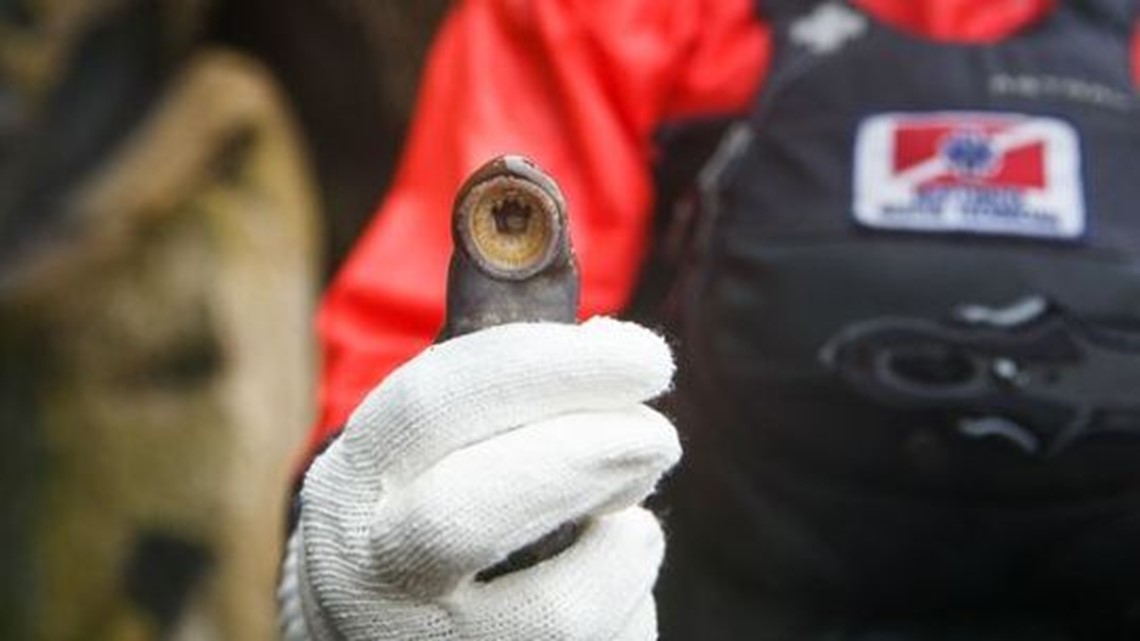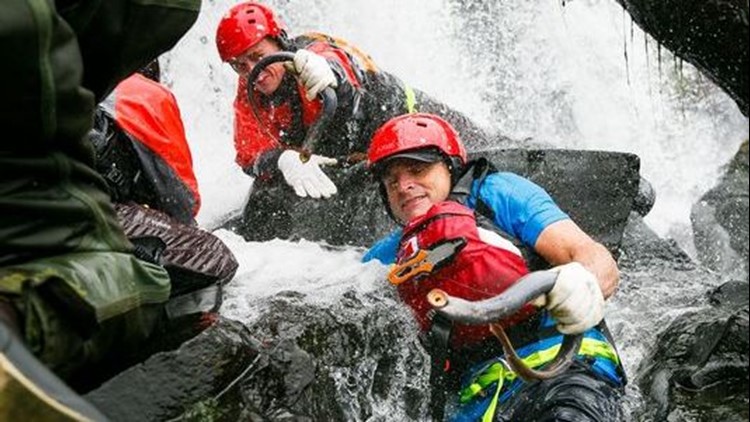Kelly Dirksen dives into a hole at the bottom of Willamette Falls, under the shadow of abandoned industrial buildings on the Willamette River just outside Portland.
Within seconds he re-emerges, with a slimy, writhing prehistoric creature in each hand. One uses its jawless, tooth-filled sucker mouth to clamp onto his arm. He shakes it off.
More of the snake-like creatures shoot from their nest in panic. Dirksen and his team of biologists grab them mid-air. Within minutes, they’ve filled a mesh bag, which now looks like Medusa’s head.
Restoring history
It’s a scene that’s been played out for centuries, first by Native American tribes seeking food, and now by scientists trying to restore the ecologically important species, called the Pacific lamprey.
For hundreds of years, lamprey were a plentiful, culturally significant species for tribes from southern California to Alaska.
Often called eels, lamprey actually are fish, although they have no jaws or fins. They’re the oldest fish alive today, dating back around 450 million years.
But over the past century, they’ve been nearly wiped out by dams, dredging, declining water quality, changing ocean conditions and more. Until recently, they were considered a nuisance and a trash fish.
Now, Willamette Falls is one of the last remaining spots where lamprey can be easily caught, drawing tribes from all over the state for the annual harvest.


“This is a fishery that’s extremely important to native people,” said Jack Giffen, Jr., Tribal Elder for The Confederated Tribes of Grand Ronde. "Lamprey is a first food. It was a seasonal staple. And there are certain ceremonies we use the eels for."
'A first food...a seasonal staple'
The site also is where The Confederated Tribes of Grand Ronde is operating one of the region’s largest lamprey restoration projects, headed up by Dirksen, the tribes’ fish and wildlife program manager.
“Back in the 1960s, when all the dams were being finished, it cut off a lot of habitat for Pacific lamprey," project biologist Torey Wakeland said. “Some of these dams have since been retrofitted with fish passages for salmon. What we’re looking to do is re-establish lamprey populations above those.”
But restoring lamprey populations is much harder than restoring salmon runs, Wakeland explained. That’s because the weird fish have an even weirder life cycle.
Lamprey hatch from eggs as larva, called ammocoetes. For the next three to seven years, they live burrowed in the muck on river and stream bottoms, filter feeding.
Then, over a summer, they develop eyes and a mouth, becoming juveniles, or macrophthalmia.
“That literally just means big eyes,’ Wakeland said.


The next winter, they migrate to the ocean, becoming adults. There, they are parasitic to larger fish, attaching their sucker mouths to salmon, flatfish, rockfish and pollock.
They live in the ocean for three to five years, then head back to spawn. But, unlike salmon, they wait a year to spawn, without eating, until the following spring.
“It’s incredible, because they’re living off their fat reserves that whole time,” Wakeland said. “Which is why they made a really good food source, because they’re high in oils.”
Also unlike salmon, lamprey don’t necessarily return to the stream system where they were born.
Instead, it’s thought adult lamprey are attracted to the pheromones of juveniles still in the system.
Going according to plan
So tribal biologists capture lamprey at Willamette Falls and release them above Fall Creek Dam, off the Willamette River near Springfield.
Forty of the 240 fish relocated each year are radio tagged, so scientists can track their movements.
“We’re getting more and more juveniles and larval lamprey above the dam,” Wakeland said. “The thought is those pheromones will attract adult lamprey.”
The plan seems to be working.
The project began in 2014, after a small test run in 2013.
“Last year we had some juvenile lamprey moving out to the ocean,” Wakeland said. “And then this year, we’ve had some adults moving upstream. We’re seeing some migration.”
A successful restoration at Willamette Falls could extend the harvest season, which currently runs from June 1 through July 31, during certain hours only, and by special permit from the Oregon Department of Fish and Wildlife.
The four dozen or so lamprey Dirksen’s team caught, meanwhile, are headed for the tribe’s freezers, most likely to be eaten at the annual celebration of Tribal Restoration this fall.
A summer youth crew has been trained to clean and prepare the eels, and tribal youth also participate in the harvest, helping pass the tradition to new generations.
“A lot of the older elders really understand the tradition of the eels and the significance of Willamette Falls to the tribes from time immemorial,” Tribal Elder Giffen said.
“But they can’t go out and crawl around on the rocks," he said. "That’s the significance of our young kids going out and harvesting these.”
Contact the reporter at tloew@statesmanjournal.com, 503-399-6779 or follow at Twitter.com/Tracy_Loew



